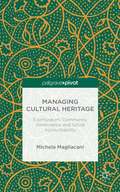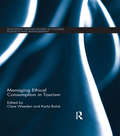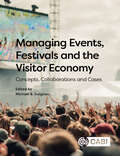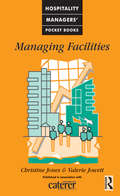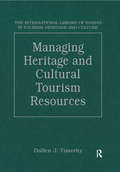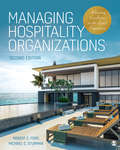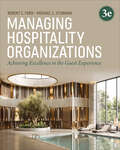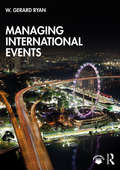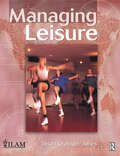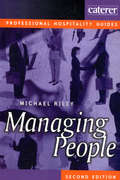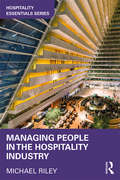- Table View
- List View
Managing Crises in Tourism: Resilience Strategies from the Caribbean
by Acolla Lewis-Cameron Sherma Roberts Leslie-Ann JordanThis book examines the dilemma of overdependence on tourism in Caribbean countries and territories, and the need for a resilient path to address the industry’s vulnerability in the face of natural disasters. The chapters in the book question how tourism resilience is understood and practiced in Caribbean small island developing states (SIDS) and the factors that inform, undermine, or indeed redefine the sustainable resilience agenda for these territories.With its overreliance on tourism and vulnerability to climate, the Caribbean region finds itself susceptible and in need of an innovative approach in order to survive economically. Contributors to this volume touch on all three sustainability pillars and spanning across many tourism sector considerations, such as product development, stakeholder management, hotel management, marketing and entrepreneurship. By spanning the geography of the Anglophone and Spanish Caribbean this book offers a smorgasbord of conceptual and applied perspectives to researchers in the area of tourism resilience in SIDS. It also presents strategic considerations to public and private sector practitioners in implementing measures to strengthen the competitive positioning of their destinations as they contend with the dynamism of the external and internal environments.
Managing Cultural Festivals: Tradition and Innovation in Europe (Routledge Research in the Creative and Cultural Industries)
by Elisa SalvadorThis book aims at renewing the attention on a niche field, Cultural Festivals, so important for valorizing cultural traditions and local heritage visibility as well as social well-being. Following the disruptive consequences of the COVID-19 pandemic, this fragile sector deserves more attention from public authorities and stakeholders at national and European levels with a suitable and dedicated plan of recovery and valorization. This book provides a comparative analysis of Cultural Festivals in Europe, taking insights from an international range of high-level scholarly contributors. Individual chapters highlight and analyse challenges around the organisation, management and economics of Cultural Festivals. As a whole, the book provides a comprehensive overview of scholarly research in this area, setting the scene for the future research agenda. Matters related to educational programs and new audience development, as well as challenges related to digitalization, are also included. The book employs a tradition versus innovation lens to help readers account for the consequences of the digital revolution, new audience development and an educational agenda. The result is a book which will be valuable reading for researchers, academics and students in the fields of event and cultural management and beyond.
Managing Cultural Heritage: Ecomuseum, Community Governance and Social Accountability
by Michela MagliacaniManaging Cultural Heritage explores managerial and governance issues within the cultural heritage sector, with particular regard to the ecomuseum. Moreover, a social accountability model is supplied to ecomuseums in order to be accountable towards its shareholder, the local community.
Managing Educational Tourism
by Brent W. RitchieIncreasingly tourists are seeking learning and educational holidays. This interest has led to the provision of tourism product with some form of learning or education as an integral component, including cultural heritage tourism and ecotourism. The growth of offshore education and lifelong learning has stimulated cross-border movement for language learning, school excursions and university student travel. Reflecting this growth in educational tourism types, the author outlines the main forms of educational tourism, their demand and supply characteristics, their impacts and the management issues associated with them, taking a holistic systems-based perspective. The book argues that without adequate research and appropriate management of educational forms of tourism, the potential regional development impacts and personal learning benefits will not be maximised. The book highlights the need for collaboration and networking between both the tourism and education industries to adequately manage the issues surrounding the growth in educational tourism.
Managing Ethical Consumption in Tourism (Routledge Critical Studies in Tourism, Business and Management)
by Clare Weeden Karla BolukNeither the tourism industry nor the tourist has responded convincingly to calls for more responsibility in tourism. Ethical consumption places pressure on travellers to manage a large number of decisions at a time when hedonic motivations threaten to override other priorities. Unsurprisingly, tensions occur and compromises are made. This book offers new insight into the motivations that influence tourists and their decision-making. It explores how consumers navigate the responsible tourism market place and provide a rich understanding of the challenges facing those seeking to encourage travellers to become responsible. Not only will the book provide an improved interpretation of the complexity of ethical consumption in tourism, but it will also offer a variety of stakeholders a deeper understanding of: the key challenges facing stakeholders in the production and consumption of responsible tourism how ethical consumers can be influenced to consume ethically the gaps in consumer knowledge and how to broaden the appeal for individuals to make more informed ethical decisions how tour operators can respond to this emerging market by innovative product development how to design informative marketing communications to encourage a greater uptake for responsible holidays how destinations can tailor their products to the ethical consumer market how destination communities and management organisations can target responsible tourists through the provision of sustainable alternatives to mass-market holiday products. Written by leading academics from all over the world, this timely and important volume will be valuable reading for ubdergraduate and postgraduate students, researchers and academics interested in Tourism Ethics, Ethical Consumption and the global issue of Sustainability.
Managing Events, Festivals and the Visitor Economy: Concepts, Collaborations and Cases
by Nick Taylor Alan Fyall Elizabeth Halpenny Martin Robertson Judith Mair Hugues Seraphin Lino Briguglio Leonie Lockstone-Binney Professor Maximiliano Korstanje Dr Anna Leask Desmond Wee Tadayuki Hara Abigail Hunt Andrea Barber Ning Chris Chen Barry Ardley Marie Avellino Simon Gerard Werner Gilde Claudia Green Dr Marcus Hansen Miles Hedison Anle Li Kim Macmillian Anthony May Yong Rao Mostafa Selima Gabriel Marin Vendenbroucke Richard Voase Kenneth Wardrop Nanxi YanThis edited text, intended to support a research-informed approach to learning and teaching, presents an array of concepts, collaborations and in-depth cases related to managing events, festivals and the visitor economy. Authors offer an array of philosophical, political, cultural, and ethical perspectives on how to achieve this across a range of contexts, from Cambodia, China, Egypt to the British cathedral city of Lincoln. Though recognising individual difference, each chapter unites in their common pursuit of supporting the United Nations Sustainable Development Goals (UNSDGs). This is significant as utilising the UNSDGs as a normative organising framework for how we all think about, plan, and manage a 'good' visitor economy is increasingly ubiquitous. It is with this in mind that each chapter provides explicit links to the UNSDGs and policy and/or practical implications, along with a series of critical self-assessment questions to reflect on the chapter's key arguments. This collection aims to satiate what appears to be an increasing appetite of readers and students alike who seek exposure to rigorous debate in and out of the classroom.
Managing Events: Real Challenges, Real Outcomes
by Liz QuickCombining the practical and academic aspects of event management this text presents an industry perspective, with real-life event examples and contemporary and relevant case studies. It provides lecturers with a useful platform to integrate key event topics into the learning environment. The book discusses the management process throughout the ‘event cycle’, from the pre-event planning stage; on-site delivery to the post event stage. The book is divided into 4 distinct phases, which are: The Event cycle; Before the event; Throughout the event and Beyond the event. Within each of these 4 sections, there are 2 or 3 separate chapters, each with their own objectives. The book discusses practical and operational elements, such as project management, marketing, sponsorship deals and risk assessment, that need to be put in place both before and during the event. The final section: Beyond the event, examines current and future event trends and issues, and discusses the various career paths that exist and the skills and qualifications required to gain employment and start a successful career in events. Each chapter profiles someone currently working within the events industry, and presents a scenario of a real event challenge they have faced in their work role, relevant to the chapter. Further viewpoints from a second event practitioner and academic are included, before the final outcome is presented, showing us in each case, how real life situations develop and are resolved in practice within the events industry. The feature Event Ethics explores a topical issue that should encourage lively discussion and the Did you know? section reveals an interesting and chapter-specific event fact. At the end of every chapter students can revise and extend their event knowledge with the list of Chapter Summary Questions, which help consolidate the learning outcomes. Additionally the Key Terms section explains any terminology used within the chapter. Each chapter concludes with a section called For the Classroom, featuring discussion points and activities based around the chapter content, as well as reference sources and suggested reading. Some of the forms and inserts used to contextualise the learning, will appear as weblinks for the students to download and use throughout.
Managing Events: Real Challenges, Real Outcomes
by Liz QuickCombining the practical and academic aspects of event management this text presents an industry perspective, with real-life event examples and contemporary and relevant case studies. It provides lecturers with a useful platform to integrate key event topics into the learning environment. The book discusses the management process throughout the ‘event cycle’, from the pre-event planning stage; on-site delivery to the post event stage. The book is divided into 4 distinct phases, which are: The Event cycle; Before the event; Throughout the event and Beyond the event. Within each of these 4 sections, there are 2 or 3 separate chapters, each with their own objectives. The book discusses practical and operational elements, such as project management, marketing, sponsorship deals and risk assessment, that need to be put in place both before and during the event. The final section: Beyond the event, examines current and future event trends and issues, and discusses the various career paths that exist and the skills and qualifications required to gain employment and start a successful career in events. Each chapter profiles someone currently working within the events industry, and presents a scenario of a real event challenge they have faced in their work role, relevant to the chapter. Further viewpoints from a second event practitioner and academic are included, before the final outcome is presented, showing us in each case, how real life situations develop and are resolved in practice within the events industry. The feature Event Ethics explores a topical issue that should encourage lively discussion and the Did you know? section reveals an interesting and chapter-specific event fact. At the end of every chapter students can revise and extend their event knowledge with the list of Chapter Summary Questions, which help consolidate the learning outcomes. Additionally the Key Terms section explains any terminology used within the chapter. Each chapter concludes with a section called For the Classroom, featuring discussion points and activities based around the chapter content, as well as reference sources and suggested reading. Some of the forms and inserts used to contextualise the learning, will appear as weblinks for the students to download and use throughout.
Managing Events: Real Challenges, Real Outcomes
by Liz QuickThis introduction to managing events, written by an events professional and lecturer, combines a much-needed real-world industry perspective with essential academic concepts for success in both your studies and career. Each chapter guides you through the important stages of the event process, discusses events of all types and sizes, and introduces key trends and issues in the industry. This new edition includes all new, real-life examples which look at challenges and success stories, and explore how the events industry is evolving following the Covid 19 pandemic and as new technologies emerge. Learning features include insights into career paths from practitioners, with anecdotes on how they overcome real event challenges, Event Ethics and Did You Know boxes, case studies, and questions, discussion points and activities at the end of each chapter. Managing Events is the essential companion for anyone studying events and events management at college or university, or for those already working in the industry who are looking to develop their event skills. Liz Quick is a senior lecturer on the BA Event Management course at the University of West London.
Managing Events: Real Challenges, Real Outcomes
by Liz QuickThis introduction to managing events, written by an events professional and lecturer, combines a much-needed real-world industry perspective with essential academic concepts for success in both your studies and career. Each chapter guides you through the important stages of the event process, discusses events of all types and sizes, and introduces key trends and issues in the industry. This new edition includes all new, real-life examples which look at challenges and success stories, and explore how the events industry is evolving following the Covid 19 pandemic and as new technologies emerge. Learning features include insights into career paths from practitioners, with anecdotes on how they overcome real event challenges, Event Ethics and Did You Know boxes, case studies, and questions, discussion points and activities at the end of each chapter. Managing Events is the essential companion for anyone studying events and events management at college or university, or for those already working in the industry who are looking to develop their event skills. Liz Quick is a senior lecturer on the BA Event Management course at the University of West London.
Managing Facilities
by Christine Jones Valerie JowettManaging Facilities provides a clear introduction to the concepts, development and application of managing facilities in hotels. Premises and services operations management are considered through the application of generic management techniques. In hotels, buildings, land, assets, people and services are essential resources which need to be managed to meet organizational objectives. Through practical techniques and examples, Jowett and Jones show how these facilities can be continuously improved to increase competitiveness and meet the ever changing needs of the customer.Managing Facilities is:· the only UK book to reflect modern facilities management practices in hospitality· full of practical examples· a reference source and introduction in one formatManaging Facilities is a concise guide for hotel, hospitality and facilities managers. It is also an excellent text for undergraduate and postgraduate students of hospitality management.Val Jowett MSc FHCIMA is Principal Lecturer at Leeds Metropolitan University and has taught Accommodation Management, and now Facilities Management, for over 25 years. In her earlier career she worked for British Transport hotels and then in Domestic Services Management in the N.H.S. She has taught in the USA and India and now manages a series of developmental initiatives which centre around NVQs, mentoring and careers development learning.Christine Jones BA MIMgt MHCIMA is the Head of School of Business and Professional Studies at Burton Upon Trent College. She has a wide range of occupational and research experience in the hospitality industry and has held teaching posts in a number of Further and Higher Educational establishments.
Managing Front Office Operations
by Michael L. KasavanaThe tenth edition features several new sections related to the impact of technology on hotel operations, including information on social media platforms, mobile services, mobile device connectivity issues guests may experience in hotels, mobile payments, and how the Internet of Things will affect guest service. New material has been added on key cards and keyless entry technology. In addition, the section on income statements has been revised to reflect the most recent edition of the Uniform System of Accounts for the Lodging Industry.
Managing Heritage and Cultural Tourism Resources: Critical Essays, Volume One (The International Library of Essays in Tourism, Heritage and Culture)
by Dallen J TimothyThis three volume reference series provides an authoritative and comprehensive set of volumes collecting together the most influential articles and papers on tourism, heritage and culture. The papers have been selected and introduced by Dallen Timothy, one of the leading international scholars in tourism research. The first volume 'Managing Heritage and Cultural Tourism Resources' deals primarily with issues of conservation, interpretation, impacts of tourism and the management of those impacts. Sold individually and as a set, this series will prove an essential reference work for scholars and students in geography, tourism and heritage studies, cultural studies and beyond.
Managing Hospitality Experiences
by Peter Cox Josephine Pryce Alexandra Kenyon Ade Oriade Roya Rahimi Dr Peter Robinson Adenike Adebayo Rudin Beka Kevan Burke Sandra J Cooper Martin Hilton James Musgrave Lucy Hack Gonzalo Díaz MenesesManaging hospitality experiences is a crucial part of the hospitality business and industry alike. While many textbooks cover the management of hospitality services, this text focuses specifically on experiences, while also providing a full and detailed insight into the ways in which experiences are designed and delivered. Using examples from the gamut of hospitality, this book explores issues around people, services and spaces. It covers management issues such as marketing, human resources, operations, quality management, facilities management, project management and strategy, while considering hospitality operations within their wider geo-social and geo-environmental settings. This book includes a range of important contemporary topics, such as sustainability, resilience and ethics; supported throughout by learning objectives, case studies, review questions, links to videos and further reading suggestions. This book: Emphasises experiences within hospitality, providing students with a focused and applicable text. Includes numerous international industry case studies to illustrate how hospitality organisations manage experiences; these real-life scenarios provide key teaching points. Provides wider theoretical principles to develop the field of hospitality and place it within an industry context. An invaluable read for undergraduate students of hospitality and event management, this textbook also provides an overview for postgraduate students and those studying further education courses in hospitality and related areas.
Managing Hospitality Human Resources
by Robert Woods<p>HUMAN resources is an ever-changing field. Keeping up with it is mandatory for hospitality business leaders for a variety of reasons, including remaining in compliance with government regulations and developing an effective hospitality service organization. <p>When the first edition of Managing Hospitality Human Resources came out in 1994, there were real reasons for the hospitality industry to worry about having enough employees in the future. During the 1990s, hospitality suffered from a shortage of employees, high turnover rates, and image issues in some areas. By the late 2000s the turnover issue had been mostly addressed, although the potential for recurrence of the problem still persists. Hospitality's image has been greatly repaired from the days of the Resolution Trust Corporation in 1989 and similarly troubled organizations in the years after, when many hotels were auctioned off after hundreds of savings and loan organizations failed. The industry became much leaner, and stayed lean due in part to the Great Recession, which officially began in December of 2007. Hospitality organizations today are pretty savvy. As a general rule, they stay on top of human resources issues and have developed many new HR programs to improve the hospitality workplace and help end the impression that a hospitality job is a way station in life--an image that has persisted for much of the industry's modern existence.</p>
Managing Hospitality Organizations: Achieving Excellence in the Guest Experience
by Michael C. Sturman Robert C. FordManaging Hospitality Organizations: Achieving Excellence in the Guest Experience takes students on a journey through the evolving service industry. Each chapter focuses on a core principle of hospitality management and is packed with practical advice, examples, and cases from some of the best companies in the service sector. Students will learn invaluable skills for managing the guest experience in today’s ultracompetitive environment. The Second Edition includes new coverage of technology, sustainability, sexual harassment, diversity and inclusion, and ethical leadership.
Managing Hospitality Organizations: Achieving Excellence in the Guest Experience
by Michael C. Sturman Robert C. FordManaging Hospitality Organizations: Achieving Excellence in the Guest Experience takes students on a journey through the evolving service industry. Each chapter focuses on a core principle of hospitality management and is packed with practical advice, examples, and cases from some of the best companies in the service sector. Students will learn invaluable skills for managing the guest experience in today’s ultracompetitive environment. The Second Edition includes new coverage of technology, sustainability, sexual harassment, diversity and inclusion, and ethical leadership.
Managing Hospitality Organizations: Achieving Excellence in the Guest Experience
by Michael C. Sturman Robert C. FordIntroduction to Hospitality Management: Achieving Excellence in the Guest Experience, Third Edition takes students on a journey through the evolving service industry. Each chapter focuses on a core principle of hospitality management and is packed with practical advice, examples, and cases from some of the best companies in the service sector. Authors Robert C. Ford and Michael Sturman emphasize the critical importance of focusing on the guest and creating an unforgettable customer experience. Whether your students will be managing a neighborhood café, a convention center, or a high-end resort hotel, they will learn invaluable skills for managing the guest experience in today’s ultracompetitive environment. Included with this title: LMS Cartridge: Import this title’s instructor resources into your school’s learning management system (LMS) and save time. Don’t use an LMS? You can still access all of the same online resources for this title via the password-protected Instructor Resource Site. Learn more.
Managing Hospitality Organizations: Achieving Excellence in the Guest Experience
by Michael C. Sturman Robert C. FordIntroduction to Hospitality Management: Achieving Excellence in the Guest Experience, Third Edition takes students on a journey through the evolving service industry. Each chapter focuses on a core principle of hospitality management and is packed with practical advice, examples, and cases from some of the best companies in the service sector. Authors Robert C. Ford and Michael Sturman emphasize the critical importance of focusing on the guest and creating an unforgettable customer experience. Whether your students will be managing a neighborhood café, a convention center, or a high-end resort hotel, they will learn invaluable skills for managing the guest experience in today’s ultracompetitive environment. Included with this title: LMS Cartridge: Import this title’s instructor resources into your school’s learning management system (LMS) and save time. Don’t use an LMS? You can still access all of the same online resources for this title via the password-protected Instructor Resource Site. Learn more.
Managing International Events
by W. Gerard RyanThis book provides a comprehensive overview and examination of the international aspect of Events Management and the many challenges and complications that arise in the planning and delivery specifically of cross-border and cross-cultural events. Authored by a current academic and ex-practitioner in the field, this book boasts an excellent balance of theory with practical advice and guidance. Chapters cover all the key concepts needed to manage and deliver an international event and fully reflect the current trends and issues facing the sector today. These include: sustainability, digital communication, social media, Big Data, corporate social responsibility, accessibility, security issues, and managing volunteers among many others. International case studies are included in each chapter accompanied by study questions and useful weblinks for further reading and research. This will be of great interest not only to students and researchers of International Events Management, Tourism and Hospitality, but also to current practitioners in the Events sector.
Managing Leisure
by Byron Grainger-JonesManaging Leisure is an excellent reference tool for both students and practitioners in the leisure industry.It provides detailed and practical advice on managing buildings, budgets and people. It also covers the vital aspects of law, finance, health & safety and competitive tendering. Managing Leisure takes management theory and looks at its practical application in a leisure management context.Ideal for students studying leisure management, this book will also appeal to practitioners in the field as a handy reference book.
Managing Natural and Cultural Heritage for a Durable Tourism
by Anna Trono Valentina Castronuovo Petros KosmasThis contributed volume offers a wealth of cases that explore the factors and conditions required for heritage tourism to be economically and socially beneficial to local communities without impairing the natural environment, cultural heritage preservation, or sustainability for future generations. The studies presented here comprise an examination of measures which have been and can be implemented to ensure sustainable use of natural and cultural systems, leading to a new concept of tourism that incorporates science and community practices together to create a favorable environment where tourists and locals can experience meaningful interactions and experiences. The book focuses on the role of stakeholders in the development of a new policy regarding the sustainable management of cultural tourism and the possibility of their involvement in the processes governing policy-making. Emphasis is placed on the role and commitment of local and international authorities, including UNESCO, in preserving the world's endangered cultural and natural heritage, as well as the responsibilities of Member States and public and private actors with respect to future conservation challenges.
Managing People (Hospitality Essentials Ser.)
by Michael Riley Andrew ThompsonThis new second edition of 'Managing People' provides a practical approach to applying up-to-the-minute management techniques, and is a vital source of information for professionals in the hotel and catering industry responsible for personnel and training. Riley explores how aspects such as labour cost, utilization, labour market behaviour and pay are inseparable from the skills of people management. In the new edition he extends his ideas on productivity so as to encompass its relationship with functional flexibility. In a similar manner, thinking about motivating people is extended to include modern ideas about commitment. We all loosely refer to peoples' attitude but here he shows the complexity that lies behind them. It is especially of relevance for managers with responsibility for personnel and training, and degree-level students will also find its non-prescriptive, user-friendly approach helpful.Michael Riley has extensive experience in the hotel and tourism industry and communicates in a way that reflects that experience.
Managing People in Commercial Kitchens: A Contemporary Approach (Routledge Focus on Tourism and Hospitality)
by John Cooper Charalampos Giousmpasoglou Evangelia Marinakou Anastasios ZopiatisManaging People in Commercial Kitchens: A Contemporary Approach uses original research to argue that senior managers (head chefs) should differentiate their people management practices in kitchen brigades from those used in the hospitality industry more generally (induction, socialisation, and performance evaluation) due to the group’s strong occupational identity and culture. The understanding of chefs’ work from a management perspective is critical for successful hospitality operations but has been historically under-researched. Chapters provide a detailed account of chefs’ work in commercial kitchens from an HRM perspective. Using occupational identity and culture as a vehicle, this book explores the different aspects of managerial work in commercial kitchen settings: general management, leadership, education and training, skills and competencies, managing deviant behaviour, managing stress, and managing diversity (focused on gender segregation). The final chapter looks at future perspectives on this unique working environment and the many challenges arising from the latest developments such as the COVID-19 pandemic. Providing both theoretical insights and practical applications with the use of case studies throughout, this will be of great interest to upper-level students and researchers in hospitality, as well as a useful reference for current managers in the field.
Managing People in the Hospitality Industry (Hospitality Essentials Series)
by Michael RileyThis is a book about being a successful manager in the complex hospitality industry. Approaching the subject in the context of personal development, it offers future managers essential knowledge and insight into the opportunities, the constraints, the problems and the solutions that face management at any level in the industry. Structured in six parts, this comprehensive volume is not merely concerned with the social and psychological aspects of people management, but also with the economics of labour, including: labour costs, utilisation, labour market behaviour and pay. These aspects are conjoined in the book with the skills of people management to reflect the dynamics of real-life practice. Combining theory and practice, Managing People in the Hospitality Industry offers a concise portrait of the industry at work and is essential reading for the hospitality managers of tomorrow.


